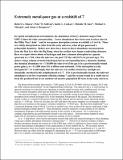Extremely metal-poor gas at a redshift of 7
Author(s)
Simcoe, Robert A.; Sullivan, Peter W.; Kao, Melodie M.; Burgasser, Adam J.; Cooksey, Kathy; Matejek, Michael Scott; ... Show more Show less
DownloadSimcoe_Extremely metal.pdf (1.421Mb)
PUBLISHER_POLICY
Publisher Policy
Article is made available in accordance with the publisher's policy and may be subject to US copyright law. Please refer to the publisher's site for terms of use.
Terms of use
Metadata
Show full item recordAbstract
In typical astrophysical environments, the abundance of heavy elements ranges from 0.001 to 2 times the solar value. Lower abundances have been seen in selected stars in the Milky Way’s halo(1, 2, 3) and in two quasar absorption systems at redshift z = 3 (ref. 4). These are widely interpreted as relics from the early Universe, when all gas possessed a primordial chemistry. Before now there have been no direct abundance measurements from the first billion years after the Big Bang, when the earliest stars began synthesizing elements. Here we report observations of hydrogen and heavy-element absorption in a spectrum of a quasar at z = 7.04, when the Universe was just 772 million years old (5.6 per cent of its present age). We detect a large column of neutral hydrogen but no corresponding metals (defined as elements heavier than helium), limiting the chemical abundance to less than 1/10,000 times the solar level if the gas is in a gravitationally bound proto-galaxy, or to less than 1/1,000 times the solar value if it is diffuse and unbound. If the absorption is truly intergalactic(5, 6), it would imply that the Universe was neither ionized by starlight nor chemically enriched in this neighbourhood at z ≈ 7. If it is gravitationally bound, the inferred abundance is too low to promote efficient cooling(7, 8), and the system would be a viable site to form the predicted but as yet unobserved massive population III stars.
Date issued
2012-12Department
MIT Kavli Institute for Astrophysics and Space ResearchJournal
Nature
Publisher
Nature Publishing Group
Citation
Simcoe, Robert A., Peter W. Sullivan, Kathy L. Cooksey, Melodie M. Kao, Michael S. Matejek, and Adam J. Burgasser. Extremely Metal-poor Gas at a Redshift of 7. Nature 492, no. 7427 (December 5, 2012): 79-82.
Version: Author's final manuscript
ISSN
0028-0836
1476-4687